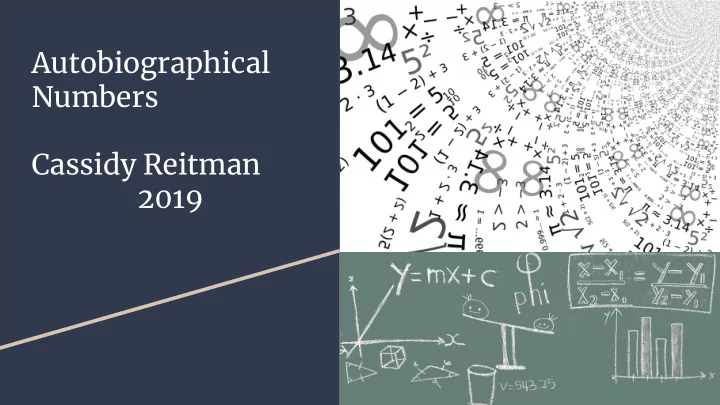

Autobiographical Numbers Cassidy Reitman 2019
What are ● Autobiographical numbers autobiographical are self descriptive numbers? ◦ Each digit represents the number of the value of the digit below occurs. ◦ Tie sum of the values of all of the digits is equal to the number of digits in the number.
Problem Statement My challenge was to come up with all of the autobiographical numbers. Tie criteria for the numbers is difficult, so there were not many numbers to find.
1210 Results: 2020 21200 3211000 42101000 521001000 6210001000 To find the low digit numbers I used trial and error. 1210, 2020, and 21200 were easy to find. I started with the first digit that contributes to the number of zeros. Next, I added the zero(s) at the end of the equation, and finally, used basic logic and reasoning to discover the 2nd and 3rd digits.
Results (continued) To find the high digit numbers, I found a pattern. All of the high digit numbers start with (x21.) X is equal to the number of digits, -4. For a 10 digit number case, x would equal 6. 6210001000 is a 10 digit autobiographical number, and it starts with x21. As well as 521001000, 42101000, and 3211000. Tie only difference between my strategy for finding low digit autobiographical numbers and high digit autobiographical numbers is the pattern I found for the high digit autobiographical numbers.
Conclusion: To make my challenge harder, I would find all I completed my challenge by finding a pattern autobiographical numbers in hexadecimal. and learning new things as a work through the Hexadecimal is a base 16 number system, unlike problem. I found all 7 autobiographical numbers, our base 10. Tiis allows me to have large values like and interested myself into number sequences. 15, into one digit. Hexadecimal is much more difficult because it is easy to confuse the two due to their similarities. Autobiographical numbers are an interesting, fun, and difficult number sequence.
Recommend
More recommend